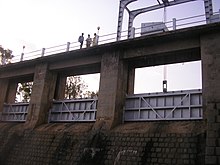| Thippagondanahalli Dam | |
|---|---|
 Tippagondanahalli dam floodgates | |
| Country | India |
| Location | 35 kilometres (22 mi) west of Bangalore |
| Coordinates | 12°58′24″N 77°20′33″E / 12.97333°N 77.34250°E |
Thippagondanahalli Reservoir, also known as T G Halli Dam or Chamarajasagara, is located at the confluence of the Arkavathy and Kumudavathi rivers, 35 kilometres (22 mi) west of Bangalore, India. It is used by the Bangalore Water Supply and Sewerage Board as a major source of drinking water for western Bangalore.[1] The lake is a man-made reservoir, created by the building of a dam which was inaugurated in 1933. M. Visvesvaraya supervised the construction work.[citation needed]
Water crisis
[edit]In the summer of 2007, the lack of rain in the watershed for the reservoir, along with use of the water for the city ran the lake almost dry.[1][2]
Recreational use
[edit]Thippagondanahalli is also popular recreation location, especially during summer months. It is located on Magadi road. There is one more dam at Manchanabele in Arkavathy downstream.
See also
[edit]References
[edit]- ^ a b "It pours, but T G Halli reservoir remains dry", Deccan Herald, 27 June 2007, accessed 11 August 2007
- ^ "T.G. Halli Reservoir drying up". The Hindu. 5 April 2007. Retrieved 17 July 2018.
Well, that’s interesting to know that Psilotum nudum are known as whisk ferns. Psilotum nudum is the commoner species of the two. While the P. flaccidum is a rare species and is found in the tropical islands. Both the species are usually epiphytic in habit and grow upon tree ferns. These species may also be terrestrial and grow in humus or in the crevices of the rocks.
View the detailed Guide of Psilotum nudum: Detailed Study Of Psilotum Nudum (Whisk Fern), Classification, Anatomy, Reproduction